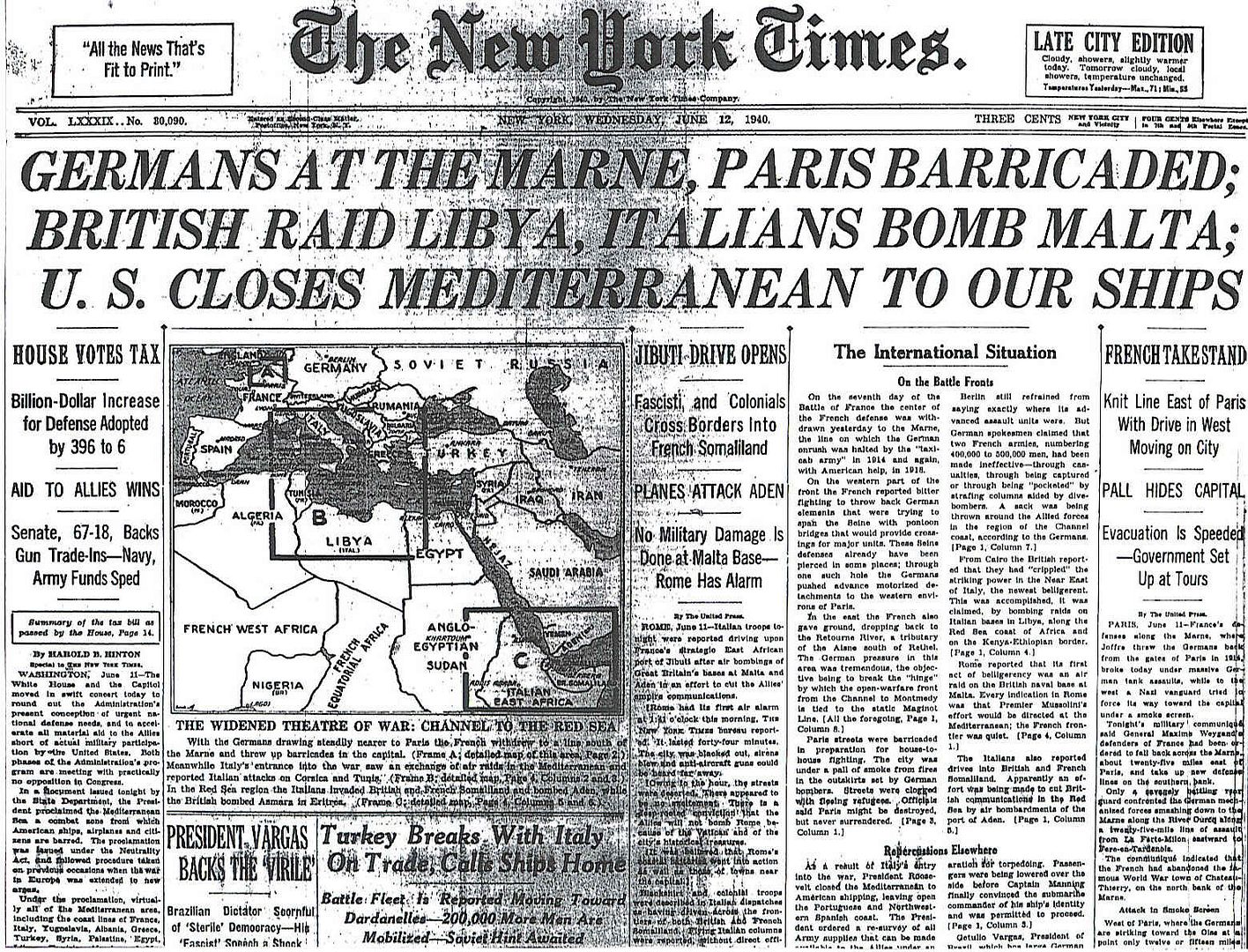
Posted on 06/12/2010 5:42:17 AM PDT by Homer_J_Simpson

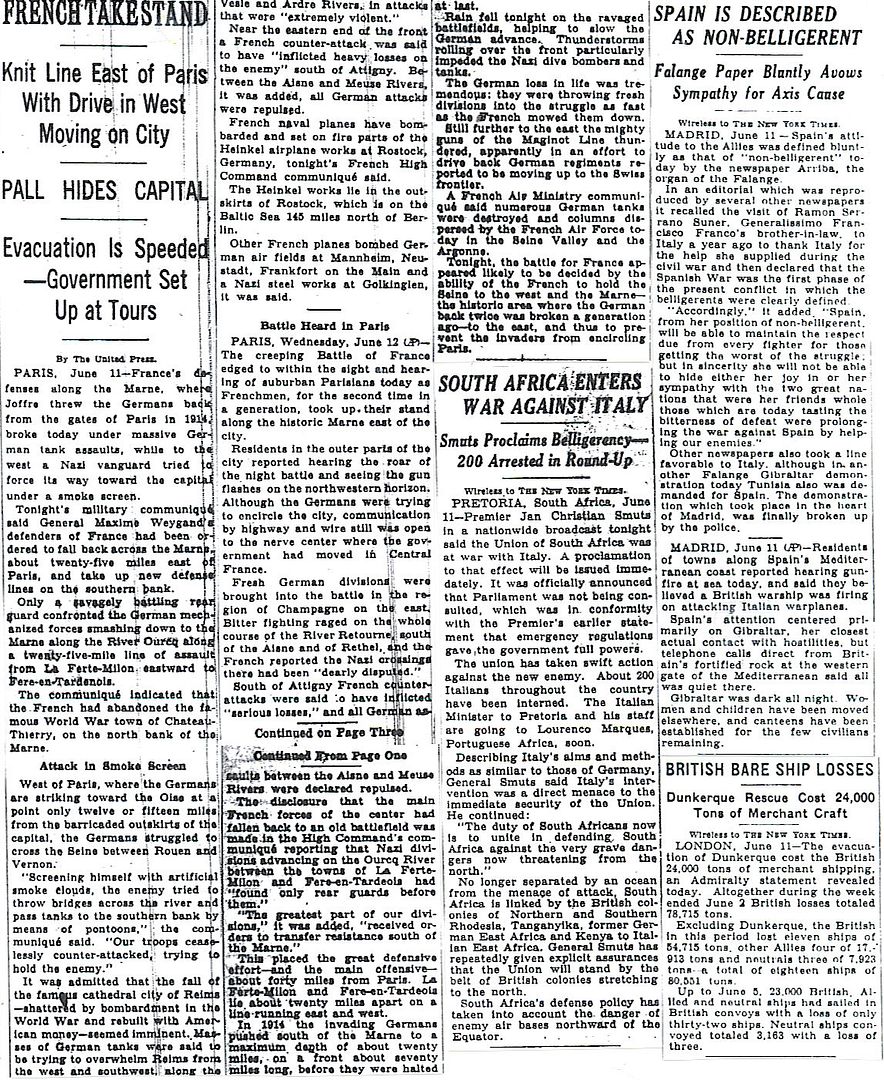
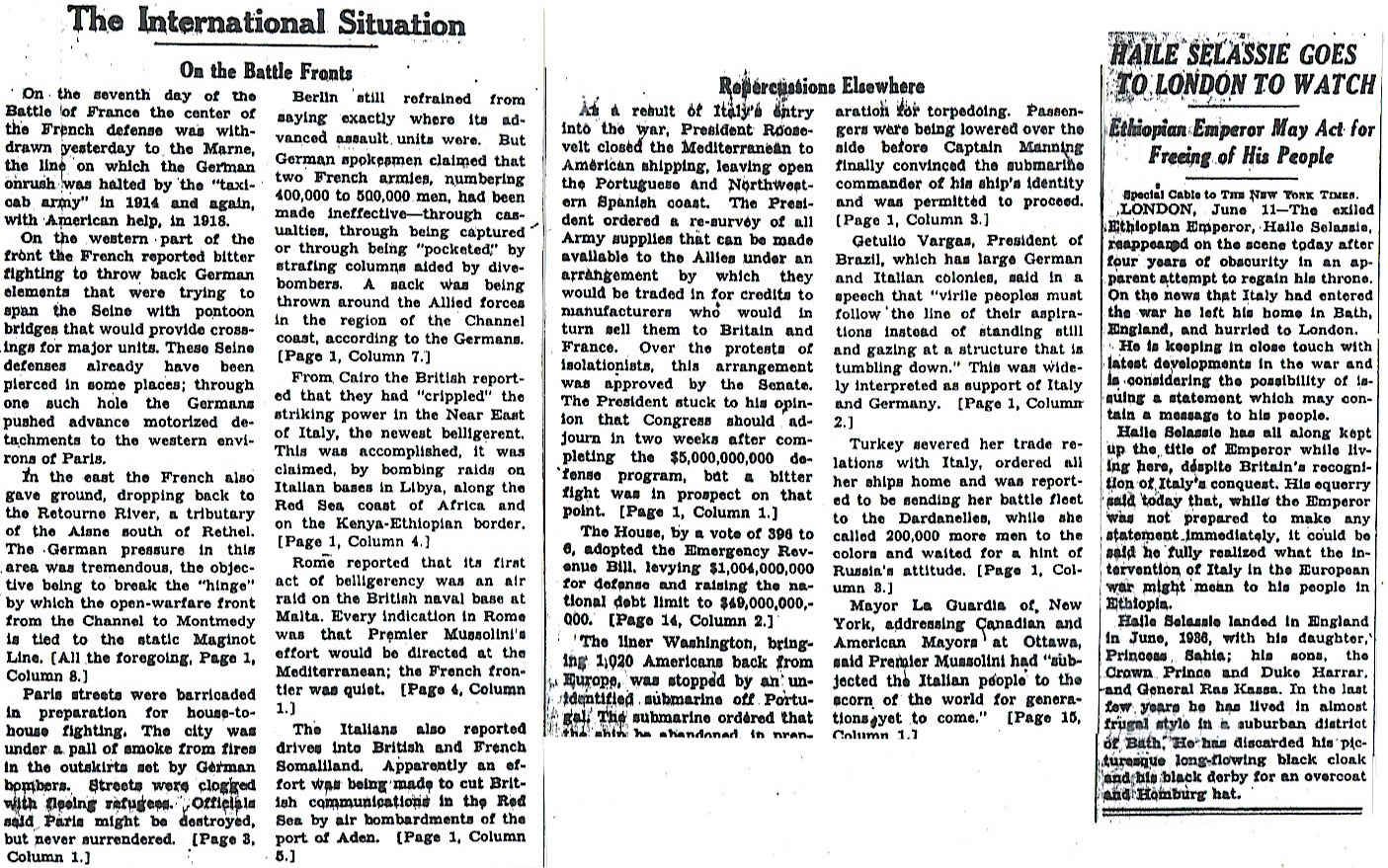
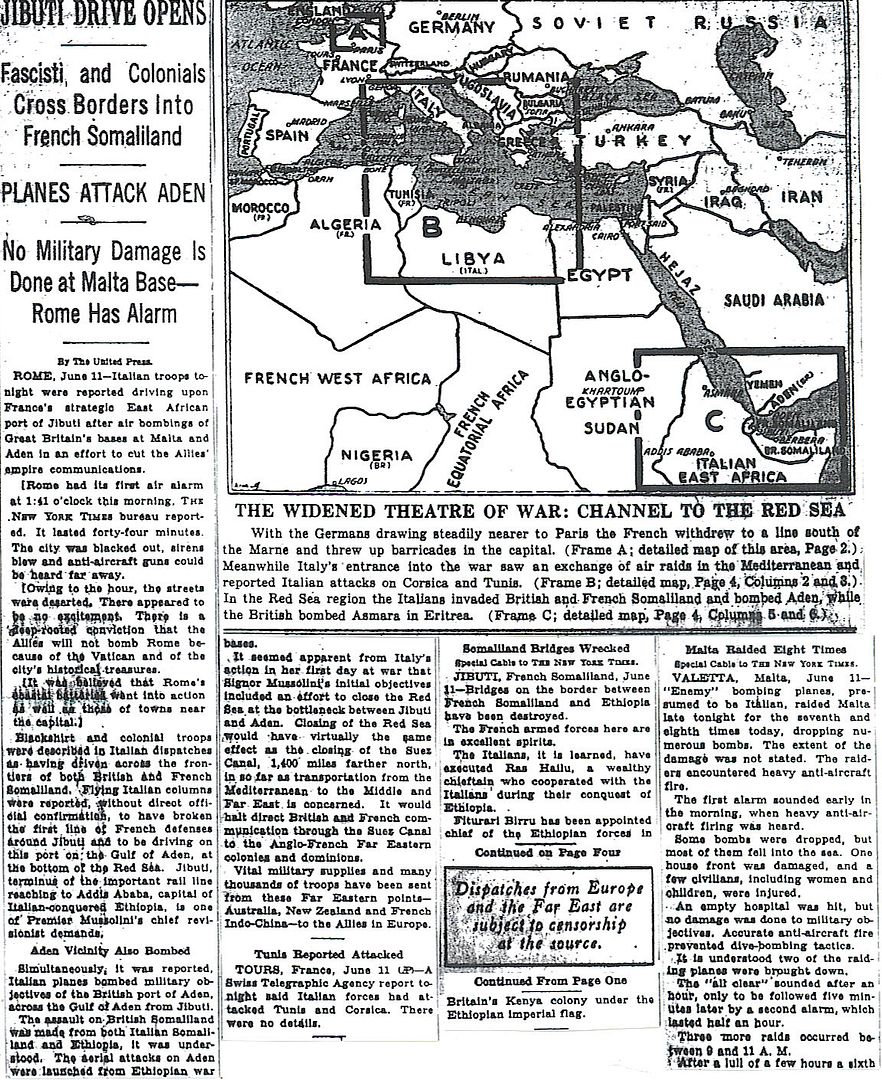
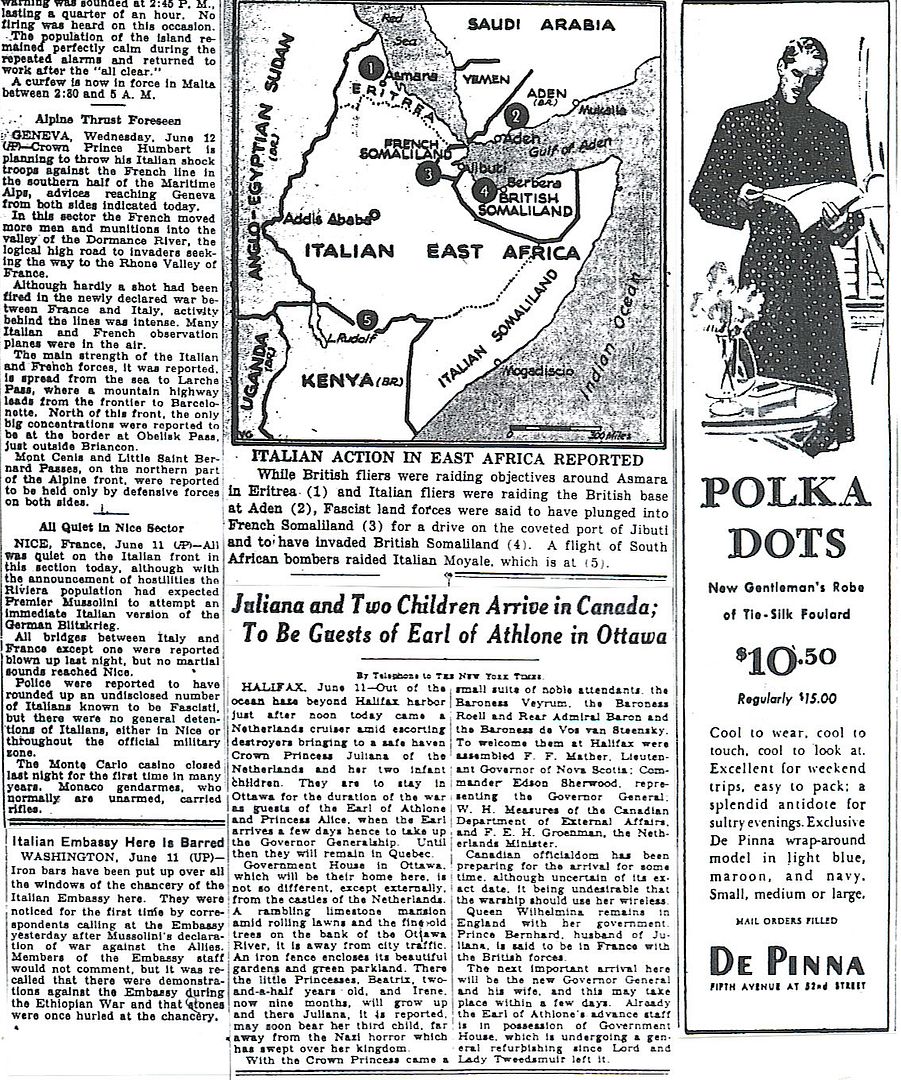
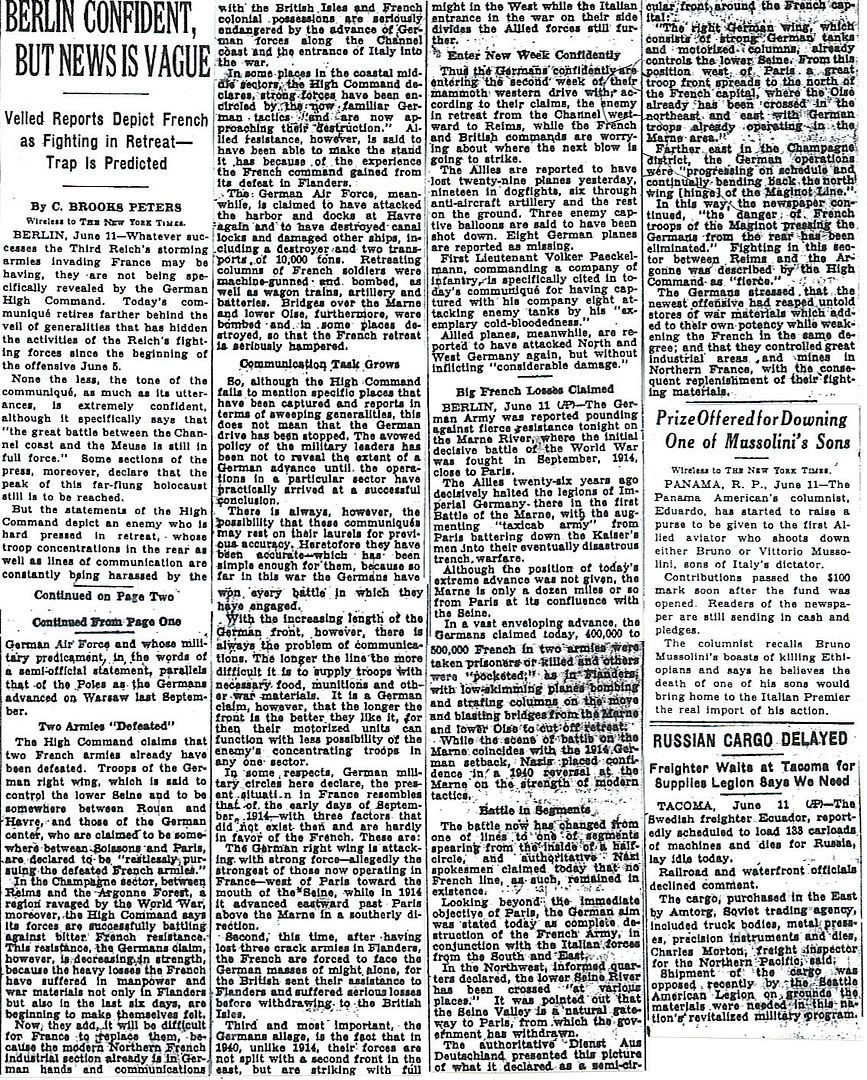
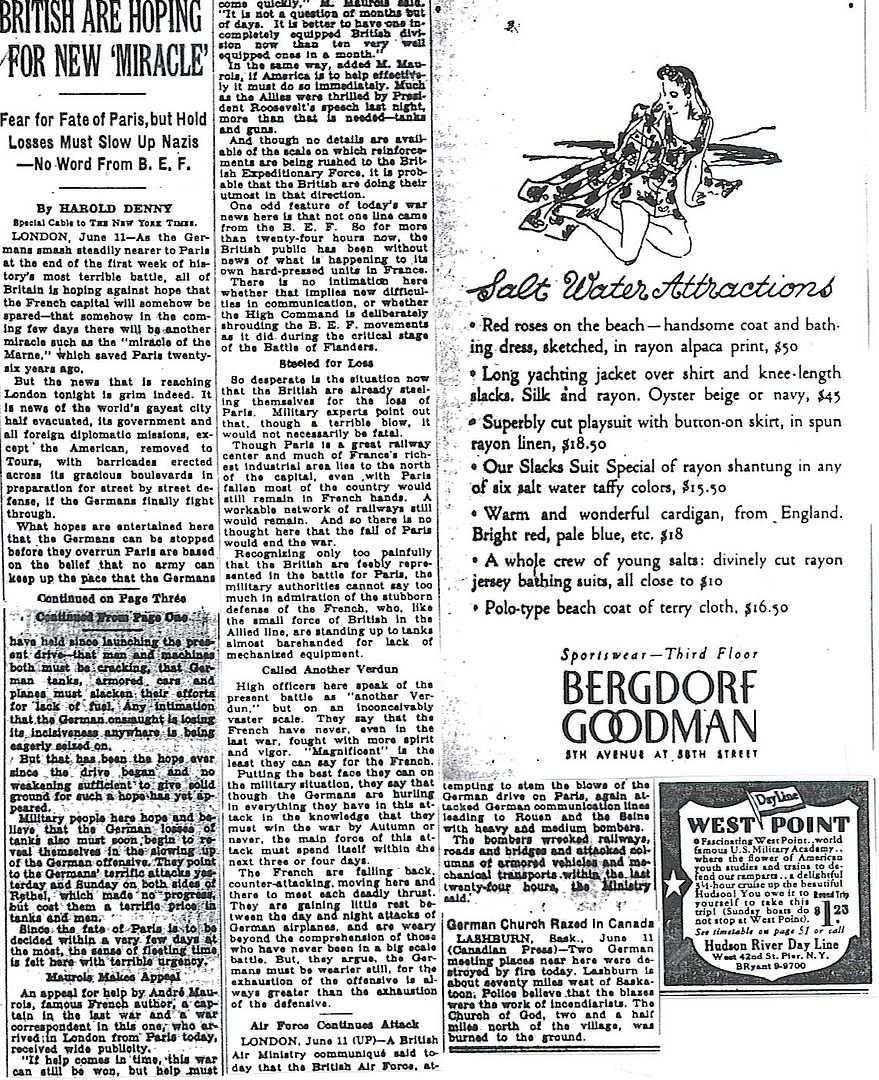
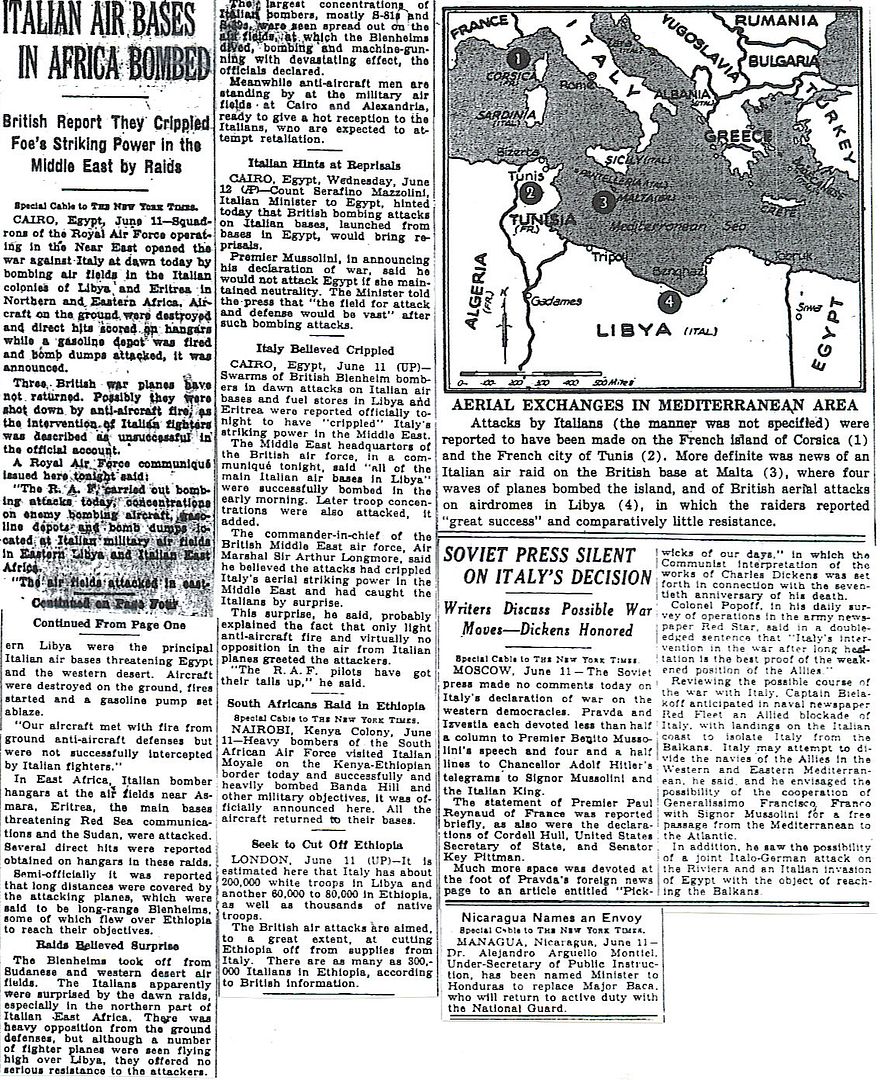
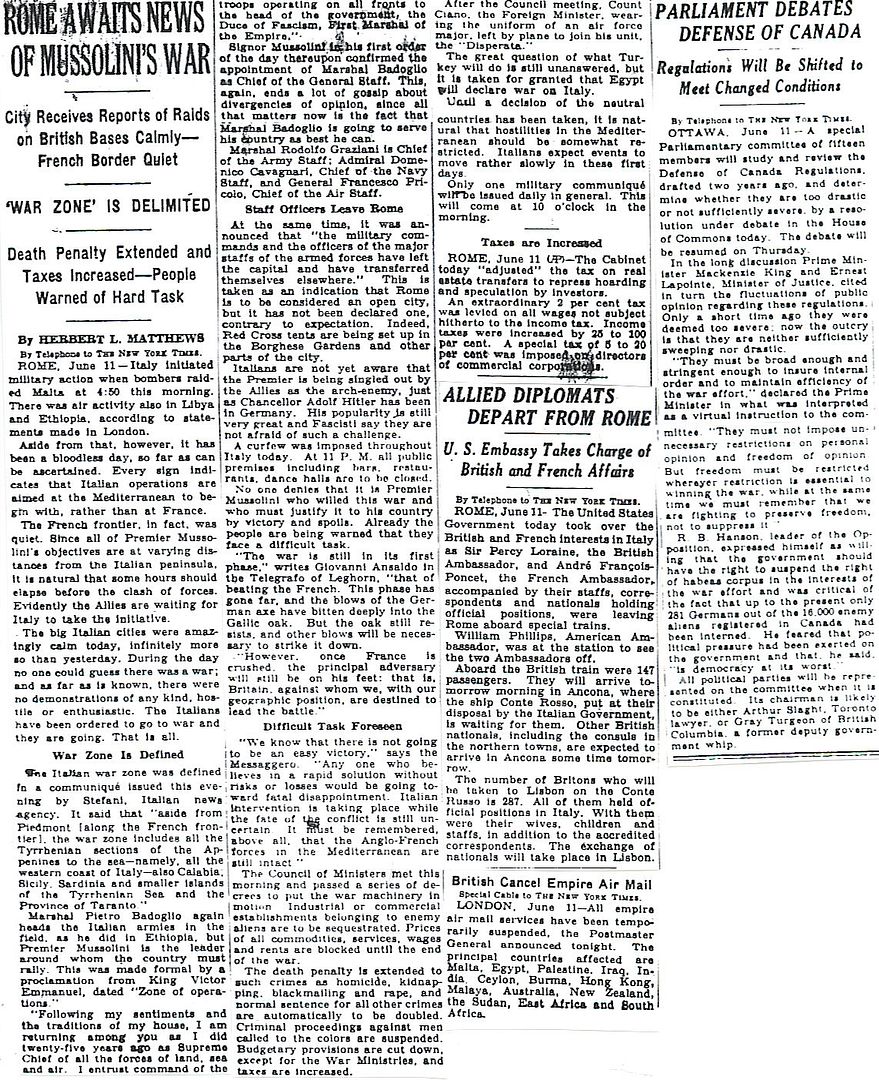
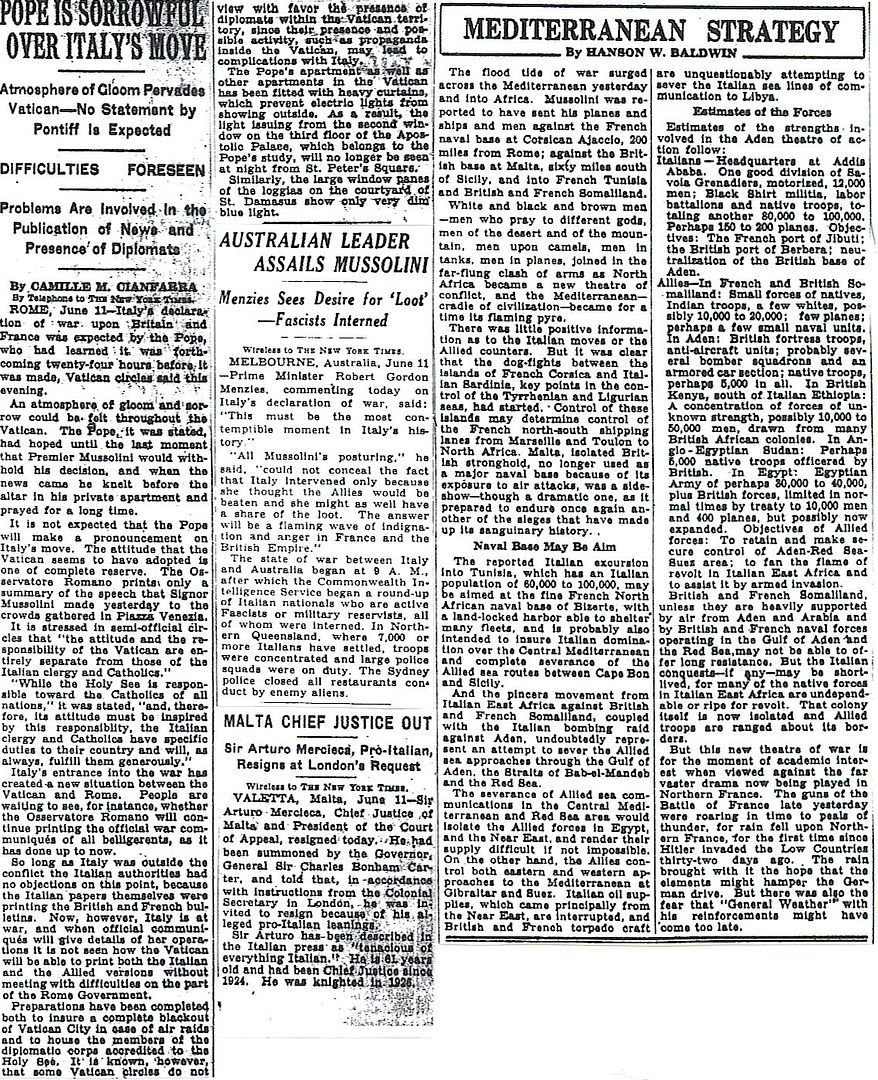
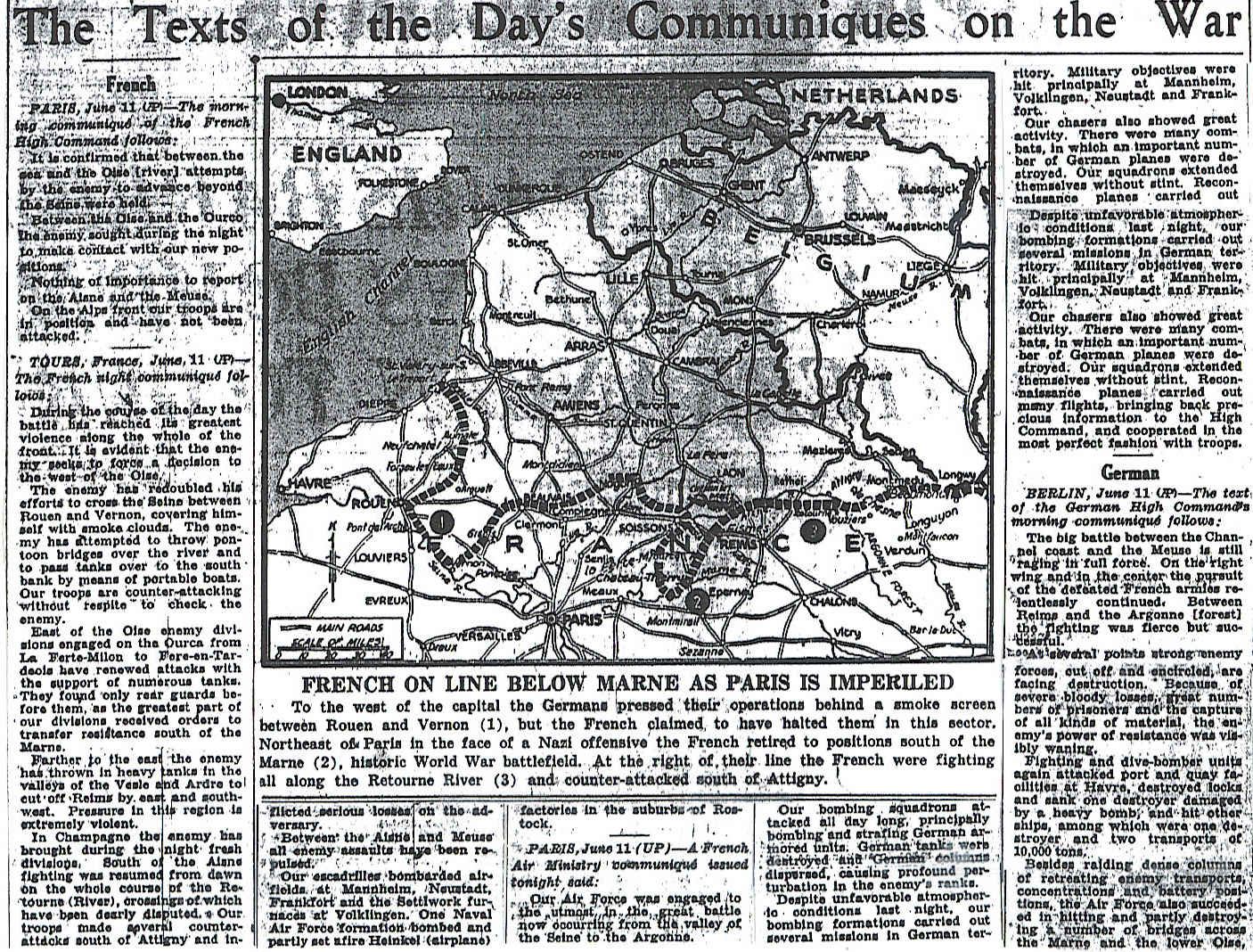
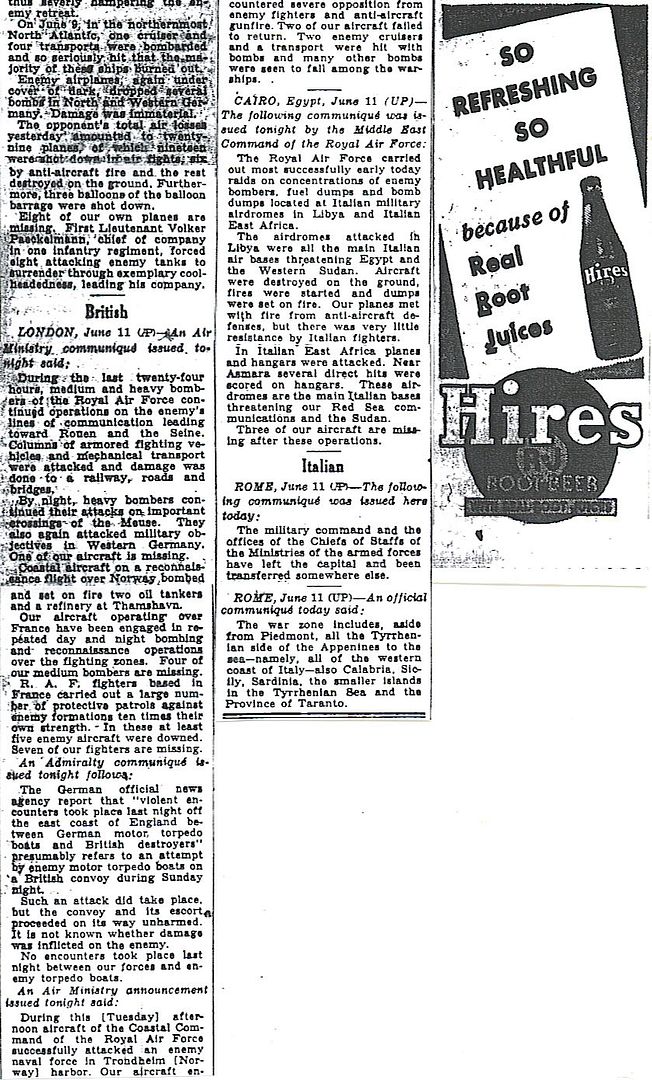
French Take Stand – 2
South Africa Enters War Against Italy – 2
Spain is Described as Non-Belligerent – 2
The International Situation – 3
Haile Selassie Goes to London to Watch – 3
Jibuti Drive Opens – 4-5
Juliana and Two Children Arrive in Canada; To Be Guests of Earl of Athlone in Ottawa – 5
Berlin Confident but News is Vague – 6
Prize Offered for Downing One of Mussolini’s Sons – 6
British Are Hoping for New ‘Miracle’ – 7
Italian Air Bases in Africa Bombed – 8
Soviet Press Silent on Italy’s Decision – 8
Rome Awaits News of Mussolini’s War – 9
Allied Diplomats Depart from Rome – 9
Parliament Debates Defense of Canada – 9
Pope is Sorrowful over Italy’s Move – 10
Australian Leader Assails Mussolini – 10
Mediterranean Strategy – 10
The Text’s of the Day’s Communiques on the War – 11-12
Their silence said enough.
http://www.onwar.com/chrono/1940/jun40/f12jun40.htm
Germans capture British division
Wednesday, June 12, 1940 www.onwar.com
On the Western Front... Guderian’s troops take Chalons-sur-Marne. Here and elsewhere the German advance continues to be very rapid. St. Valery on the Channel coast is taken. A large part of the British 51st Highland Division is captured.
In the Mediterranean... A British cruiser and destroyer force shells the Italian base at Tobruk. The main force of Admiral Cunningham’s Mediterranean Fleet is in support. An Italian force of cruisers is sent to engage the bombardment group but does not make contact. In a different action off Crete the cruiser Calypso is sunk by an Italian submarine. Turin and Genoa are bombed by the RAF.
From Moscow... The Soviet government issues an ultimatum to Lithuania demanding territory and the establishment of a new government.
http://homepage.ntlworld.com/andrew.etherington/month/thismonth/12.htm
June 12th, 1940
UNITED KINGDOM:
RAF Bomber Command: 4 Group (Whitley). Bombing - road and rail communications in France.
58 Sqn. Four aircraft to Amiens. Two bombed, one damaged by Flak.
102 Sqn. Four aircraft to Aulnoye. One returned early, two bombed.
Turin and Genoa are bombed by the RAF.
Dutch submarine O 13 departs for a patrol near the entrance of the Skagerrak, position: 57°N-05°E. The O 13 and all hands (35) are lost during this patrol. The theory that the submarine was in collision with the Polish submarine WILK is discussed here.
Minesweeping trawler HMS Sisapon mined and sunk off Harwich.
Tug HMS Twente lost due to unknown reasons.
Destroyer HMS Calpe laid down. (Dave Shirlaw)
EIRE: U-38 landed two agents in Ireland. (Dave Shirlaw)
FRANCE: Paris: The French ‘Havas News Agency’ reported on the military situation.
‘The enemy is continuing his grand efforts to force a swift decision. The German Luftwaffe has bombed French airfields and connections leading to Paris. French aircraft have bombed various German industrial cities and also took parts in the battles in France.
Chalons-sur-Marne falls to Guderian during his continued rapid advance.
Saint-Valery-en-Caux: After a brilliant defence, especially by the British General Fortune’s 51st Infantry Division, the garrison surrenders. The Germans take 40,000 prisoners, of which 8,000 are British and 12 generals.
Germany occupies Rheims and Rouen.
General Weygand orders a general retreat.
MAP
GERMANY:
U-505 laid down.
U-94 launched. (Dave Shirlaw)
NORWEGIAN CAMPAIGN: (Mark Horan): Ark Royal, having entered a storm from at noon on the 11th, turns Eastward and takes up a course for Trondheim. Word having arrived that the German capital ships that sank Glorious, Acasta, and Ardent, including both Scharnhorst and Gneisenau, as well as a Hipper class cruiser are in Trondheim and, on orders from CinC Home Fleet, Vice-Admiral Air Wells plans to strike them.
However, unlike the April operation that sank Konigsberg in Bergen, this operation has little chance of coming off by surprise. First, in April there the day was roughly half light and half darkness, so the attackers could arrive under the cover of darkness and attack at dawn. Second, Bergen Harbour is located fairly close to the North Sea coasts, so the attackers had to spend little time over land before the attackers struck. Finally, Bergen is not located near an operation airfield.
Trondheim will be a much tougher nut to crack. First, at this latitude, June contains virtually 24 hours of daylight. Second, the main harbour where the warships were anchored is some 45 miles from the coastline. Finally, Trondheim was home to the largest airfield in Norway, on which were stationed numerous single-engine and twin-engined fighters within only a few miles of the warship anchorage.
Recognizing these problems, the powers that be had come up with a three pronged attack plane. First, the new Beaufort torpedo-bombers of Coastal Command’s 22 Squadron, RAF, would make a low level attack on Vaernes airfield to keep the German fighters grounded before the attack unfolded. Second, Blenheim fighters of 254 Squadron, RAF would rendezvous with the Fleet Air Arm strike force over Ark Royal, and then provide fighter cover over the harbour itself. Finally, while the Blenheims distracted any Luftwaffe fighters that did get in the air, the Skua striking force of 800 and 803 Squadrons, FAA would execute a dive-bombing attack on the warships and then high-tail it for the ship.
In its original form, the plan had called the Swordfish torpedo bombers of 810 and 820 Squadrons to launch torpedo attack on the German warships simultaneous to the dive-bombing attack. However, the weather was simply not cooperating. The Southeasterly wind was stiff enough to severely hamper the ground speed of the Swordfish. This, combined with the nearness of the German fighter forces was such that all involved realized is was a suicidal option. Thus, the final plan called for the dive-bombing attack alone.
Exactly what their lordships actually hoped to accomplish is unclear.
The largest bombs that the Skua could carry (and the largest bombs Ark Royal’s ordnance magazines contained) was the 500 pound Semi-Armour Piercing (SAP) bomb which, even with the added impetus of the diving aircraft could not generate enough velocity to penetrate the armour decks of the primary targets, the two German battleships.
Certainly these facts were recognized by Commander Flying, Commander F. M. Stephenson, RN when he summoned each of the squadron commanders, Lt.Cdr. J. Casson, RN (803) and Capt. R. T. Partridge, RM (800), to separate interviews with Vice-Admiral L. V. Wells CB, DSO, RN where he gave each “the word.”. It would be an understatement to say that both were less than enthusiastic about the mission’s chances.
Partridge, although junior to Casson, was by now perhaps the most experienced dive-bomber pilot in the Royal Navy. He recalled bluntly that his first reaction was one “Whoever thought this one up must be absolutely bonkers, I’m not going and neither are any of my Squadron!”.
But, of course, he could not and did not. However, he took great pains to ensure that no one was mistakenly comparing this operation to the April Bergen mission. He pointed out that the key to success then, a surprise dawn attack [see above], simply would not happen here. Later, he found that Casson had, prophetically, predicted 50% losses.
However, to coin a phrase, “Their’s not to reason why, their’s but to do and die”, both set to work on the mission details and the briefings necessary for the crews involved. For this one, both agreed that only the crews with the most dive-bomber experience, regardless of seniority or assignment, should participate. Limited by the available flight deck to space to fifteen aircraft, they ultimately settled on a composition of nine Skuas in three sections from of 803 Squadron, and six in two sections from 800.
Meanwhile, around 1600, Ark broke out of the weather front and, at 1630, launched a fighter patrol of three Skuas from 800 Squadron, led by Lt. G. R. Callingham, RN. While none of the pilots was slated to fly the attack, in the event the section observer, PO(A) W. Crawford would. Later that evening, at 2230, a second patrol went up, this time with just two Skuas. While they orbited the carrier, the fifteen Skuas of the striking force were brought up and spotted. The crews manned there aircraft shortly before midnight for what would be, save one, the closing act of the NORWEGIAN CAMPAIGN.
U.S.S.R.: The USSR issues an ultimatum to Lithuania. Between now and the 22nd various communications between these countries take place. In the end the USSR prevails.
MEDITERRANEAN SEA: The Mediterranean Fleet (RN) with HMS Warspite, HMS Malaya and HMS Eagle, cruisers and destroyers sails from Alexandria for a sweep against Italian shipping in the Eastern basin. South of Crete, light cruiser HMS Calypso is torpedoed and sunk by Italian submarine Bagnolini. The British at first think this is due to a mine, but it is the first British loss caused by Italian naval forces. (Alex Gordon)(108)
The Italian fortress at Tobruk is shelled by British naval units.
MALTA: Four Hurricane’s arrive to supplement the Gladiators defending the island.
NORTH AFRICA: EGYPT: British troops capture 62 Italians in the first skirmish along the Egypt-Libya border.
Cairo: Britain replied swiftly to Italy’s declaration of war today with RAF and SAAF bombers striking at Italian aircraft on the ground, petrol depots and ammunition dumps in Libya and East Africa. The Italians were caught by surprise, according to official sources, and only light anti-aircraft fire was met. The RAF claimed that the raids had crippled Italy’s striking power in the Middle East.
CHINA: Ichang: Japanese forces are within 400 miles of the Chinese Nationalist capital, Chungking, after capturing the gateway city of Ichang today. The taking of Ichang - the westernmost city to fall to the Japanese - is the culmination of a three-month campaign by Japan’s China Expeditionary Army to put the Nationalists back on the defensive after their success at Wuyuan and their continuing guerrilla attacks on Japanese units.
Japan’s response has been to hit back with a massive invasion of the Nationalist-held provinces in south and west central China. So far the price has been high. In the see-saw battle for Tsaoyang in May the Japanese suffered 45,000 wounded or killed, and they had to pull in reinforcements from Manchukuo before taking Ichang.
JAPAN: Tokyo: A Non-Aggression Pact with Thailand is announced. (Jack McKillop)
U.S.A.: New York: Italy’s sudden entry in the war may well have provoked a pro-Allied, anti-Isolationist backlash in the United States with serious long-term consequences for the Axis.
Tomorrow’s New York Times sums up the opinions of many Americans about Italy’s sudden entry into the war. “With the courage of a jackal at the heels of a bolder beast of prey Mussolini has left his ambush,” says an editorial. It was not the decision of the Italian people, it adds. It was the decision of one man “which now takes Italy into the darkness of night and makes her people the moral enemy of every democratic people.”
The Baltimore Sun describes Italy’s action as a “long and dangerous gamble ... inevitably it is a losing one”. As other influential American newspapers joined in a chorus of disgust at Mussolini’s action, the official American view came from President Roosevelt, bringing more cheer to the Allies, anxious for America’s support.
Italy, said the President, has “scorned the rights of security of other nations”, and he added that the United States would extend to the opponents of force the material resources of his nation.
“Some still hold to the obvious delusions that the United States can become a lone island - in a world dominated by the philosophy of force,” added the President. “Such an island represents to the overwhelming majority of Americans a helpless nightmare - of a people without friends.”
ATLANTIC OCEAN:
At 1208, the unescorted Earlspark was torpedoed and sunk by U-101 NW of Cape Finisterre. The master and six crewmembers were lost. 31 crewmembers were picked up by sloop HMS Enchantress.
At 1938, the Barbara Marie in Convoy SL-34 was torpedoed and sunk by U-46 about 220 miles WNW of Cape Finisterre. At 1946, the U-boat attacked the convoy again and sank the Willowbank. The master and 31 crewmembers from the Barbara Marie were lost. The British merchantman Swedru picked up five crewmembers. (Dave Shirlaw)
http://worldwar2daybyday.blogspot.com/
Day 286 June 12, 1940
Guderian’s Panzers cross the River Marne at Chalons-sur-Marne, 80 miles East of Paris. Like Rommel’s 7th Panzer division, they have passed through the French defensive line and can travel almost at will. They will move quickly across the Langres plateau in the Champagne region into Southern France. http://upload.wikimedia.org/wikipedia/en/2/26/4June-12June_Battle_of_France.PNG
The final convoy of troopships carrying men from Narvik (Group II) arrives in the Clyde at 11 PM. French soldiers are transshipped to Brest and Lorient, which are still under French control, to continue the defense of France.
U-boats sink another 3 British merchant vessels off Cape Finisterre, Spain. At noon, U-101 sinks SS Earlspark carrying 7500 tons of coal (7 lives lost, 31 crew rescued by sloop HMS Enchantress). U-46 sinks SS Barbara Marie carrying 7200 tons of iron ore at 7.38 PM (32 lives lost) and MV Willowbank carrying 8750 tons of maize at 7.46 PM. British motor merchant Swedru picks up all 50 crew from Willowbank and 5 survivors from Barbara Marie.
http://www.uboat.net/allies/merchants/ships/346.html http://www.uboat.net/allies/merchants/ships/347.html
Thanks! Interesting read to refresh my history - especially the action that was going on in Africa.
This is great.
Military History buffs will find a gold mine of cool stuff here.
http://www.johnsmilitaryhistory.com/index.html
Virtual Tours of Revolutionary Battlefields
Virtual Tours of Civil War Battlefields
Armoured Fighting Vehicles
And much much more.
Thanks. Interesting posts.
The 51st Highland Division was reformed and fought its way through North Africa, Italy, France and finally Germany.
Many in Scotland still feel that Churchill sacrificed the 51st so that English Divisions could escape.
The 51st Highland Division was deployed to the Maginot Line It was never near the rest of the BEF and could not have been a “sacrifice”. It was a victim of bad luck and a bad location.
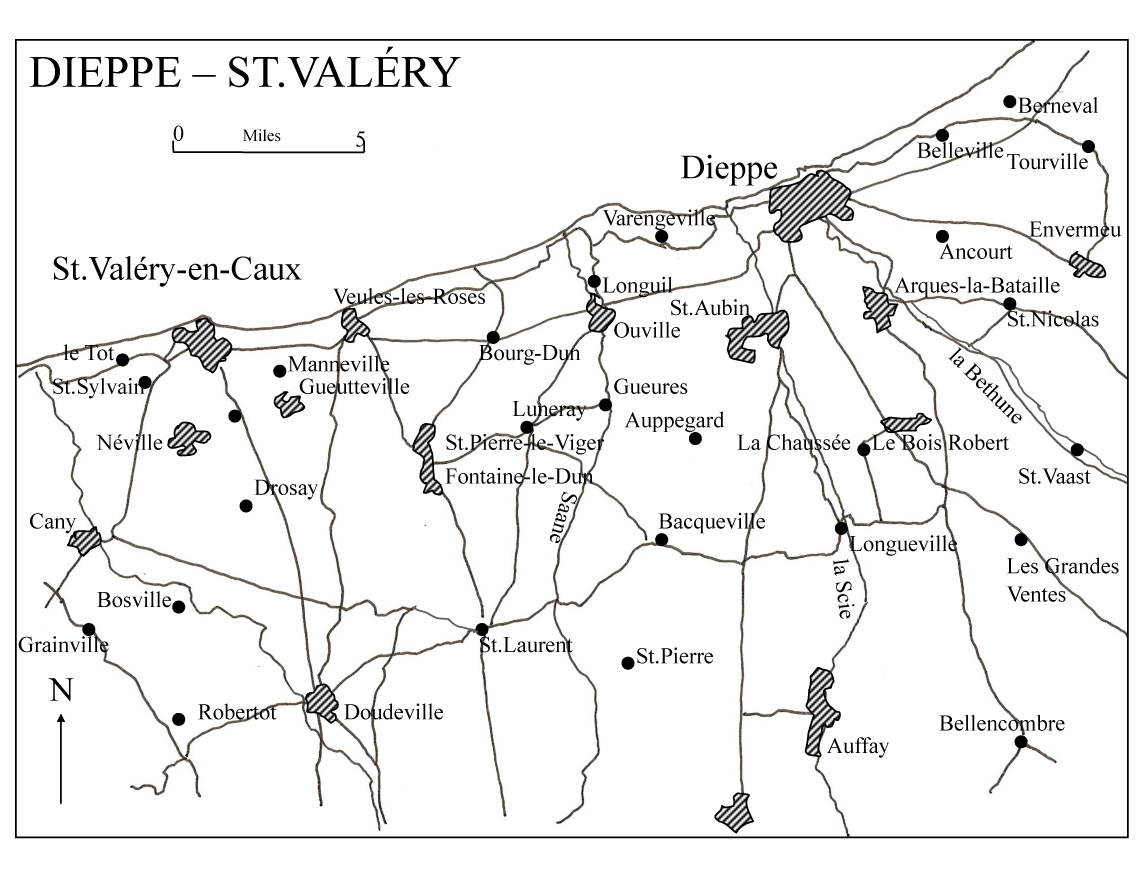
Here's a map of their deployment in the area.
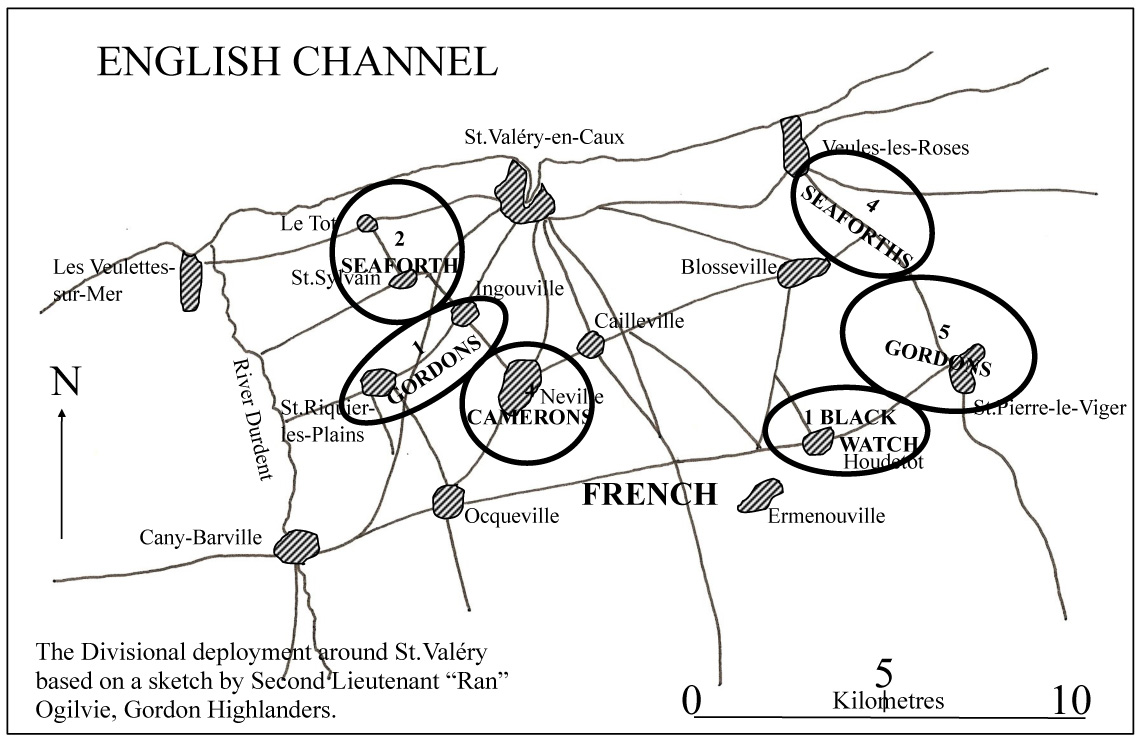
Unfortunately, the German advance was just too quick to get these units out. By the 10th, the 51st Highlands' prospects of evacuating out of La Havre had pretty much evaporated. This left them trapped and judging by the speed of the German advance down the coast, I really don't see how anyone could say they were left as sacrificial lambs. Especially when it is considered that the Navy did make an attempt to evacuate them from St.Valéry-en-Caux, though the attempt was unsuccessful since the units had not been able to fall back to the port when the navy arrived and then was forced to pull back out to sea when they came under bombardment of the Luftwaffe.
I assume they were captured.
Let's ask Cougar. He seems to have the Emerald Isle covered pretty thoroughly. And German so-called covert ops in general.
Ah yes. This would be the landing of Walter Simon on the Dingle coast. As far as I know he was the only agent landed that night of June 12-13 but Wilhelm Preetz was also landed in Ireland in June after Simon so this source may just be combining the two. This is actually a funny story so thank you for reminding me to revisit the escapades of the Abwehr on the Emerald Isle.
Simon was dropped off with the mission of setting up a weather reporting station and also to monitor British shipping in the Channel between Ireland and Britain. He had actually been on missions to Britain before the war running afoul of the Aliens Registration act in 1938 and spending 3 months in jail before being deported.
Like the account on Hermann Görtz, Simon was also dropped into Ireland unsuited for the task. The maps he was provided with were obsolete and upon reaching Dingle he immediately raised suspicion of himself when he asked workmen near the Dingle railway what time he could expect the next train to Dublin. The workmen informed him that he would have a long wait since the last train that ran on that track had passed fourteen years ago.
From there Simon wandered to the local pub in Dingle and proceeded to get drunk as he waited for a bus out of Dingle, and followed up by continuing to drink on the bus itself. Arriving at Tralee, the now smashed Simon boarded a train to Dublin and asked two men boarding the train with him if they knew anyone in the IRA.
The men turned out to be two plain-clothes detectives who phoned ahead to Dublin where Simon was picked up as he exited the train. On his person they found a paper bag that had several thousand English Pounds as well as American Dollars. He was incarcerated for the duration of the war.
Clearly Irish eyes were not smiling on the amadán bocht.
The 51st Highlander Div. was captured by Rommel’s 7th Panzer.
news.bbc.co.uk/2/hi/scotland/highlands_and_islands/10294630.stm
Disclaimer: Opinions posted on Free Republic are those of the individual posters and do not necessarily represent the opinion of Free Republic or its management. All materials posted herein are protected by copyright law and the exemption for fair use of copyrighted works.